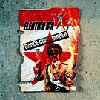 The Electric Six are most definitely a singles band. Admit it, as muchas you pretend to hate their trashy, sleazy hard rock disco, "Danger!High Voltage" got your ears perking and ass moving. So the LP wasn'tspectacular, but hey, you try keeping up the amphetamine laced worshipof fire, dancing, and the night for over a half hour (Please do notrespond with personal anecdotes of how you did this last solstice). Ifanything, the Dance Commander single will redeem the band to those who found themselves somewhat disappointed in Fire.Though "Dance Commander" is one of the better LP tracks, and anexcellent choice to stand on it's own as a single, it is the other twotracks that truly make an impression. The first is "I Am Detroit," ageographical conversation between said city and other notable locales,inviting them to tango on the dance floor of America. Luckily, theElectric Six is just the band with enough misguided confidence and zealto adopt the personification of an entire city and start makingdemands. It's a rhythm heavy rocker that will please both head boppersand hip shakers alike. The third track is a remix of "Dance Commander"by Soulchild that annihilates the original version. Gone are theoverbearing hard rock guitars, replaced by a jangly, rhythmic staccatostrum and layers of synthesizers. This is the type of music that makesthe Electric Six interesting, relentlessly danceable, musically daring,and totally pulling off their attitude, that seems to amount to "we'reso fucking serious about not being serious." With the new beat, thebest aspects of "Dance Commander" become more apparent, and when singerDick Valentine growls out "I went to the store / to get more / FIRE /to start the war!" it is utterly convincing, and phrased soexcellently. The Electric Six know what they like, and they're veryclear about it. "It would be awesome if we could dance" Who cares ifit's not deep or profound. It would be awesome if we could dance, and this single goes a long way to fulfilling that desire.
The Electric Six are most definitely a singles band. Admit it, as muchas you pretend to hate their trashy, sleazy hard rock disco, "Danger!High Voltage" got your ears perking and ass moving. So the LP wasn'tspectacular, but hey, you try keeping up the amphetamine laced worshipof fire, dancing, and the night for over a half hour (Please do notrespond with personal anecdotes of how you did this last solstice). Ifanything, the Dance Commander single will redeem the band to those who found themselves somewhat disappointed in Fire.Though "Dance Commander" is one of the better LP tracks, and anexcellent choice to stand on it's own as a single, it is the other twotracks that truly make an impression. The first is "I Am Detroit," ageographical conversation between said city and other notable locales,inviting them to tango on the dance floor of America. Luckily, theElectric Six is just the band with enough misguided confidence and zealto adopt the personification of an entire city and start makingdemands. It's a rhythm heavy rocker that will please both head boppersand hip shakers alike. The third track is a remix of "Dance Commander"by Soulchild that annihilates the original version. Gone are theoverbearing hard rock guitars, replaced by a jangly, rhythmic staccatostrum and layers of synthesizers. This is the type of music that makesthe Electric Six interesting, relentlessly danceable, musically daring,and totally pulling off their attitude, that seems to amount to "we'reso fucking serious about not being serious." With the new beat, thebest aspects of "Dance Commander" become more apparent, and when singerDick Valentine growls out "I went to the store / to get more / FIRE /to start the war!" it is utterly convincing, and phrased soexcellently. The Electric Six know what they like, and they're veryclear about it. "It would be awesome if we could dance" Who cares ifit's not deep or profound. It would be awesome if we could dance, and this single goes a long way to fulfilling that desire. The Electric Six are most definitely a singles band. Admit it, as muchas you pretend to hate their trashy, sleazy hard rock disco, "Danger!High Voltage" got your ears perking and ass moving. So the LP wasn'tspectacular, but hey, you try keeping up the amphetamine laced worshipof fire, dancing, and the night for over a half hour (Please do notrespond with personal anecdotes of how you did this last solstice). Ifanything, the Dance Commander single will redeem the band to those who found themselves somewhat disappointed in Fire.Though "Dance Commander" is one of the better LP tracks, and anexcellent choice to stand on it's own as a single, it is the other twotracks that truly make an impression. The first is "I Am Detroit," ageographical conversation between said city and other notable locales,inviting them to tango on the dance floor of America. Luckily, theElectric Six is just the band with enough misguided confidence and zealto adopt the personification of an entire city and start makingdemands. It's a rhythm heavy rocker that will please both head boppersand hip shakers alike. The third track is a remix of "Dance Commander"by Soulchild that annihilates the original version. Gone are theoverbearing hard rock guitars, replaced by a jangly, rhythmic staccatostrum and layers of synthesizers. This is the type of music that makesthe Electric Six interesting, relentlessly danceable, musically daring,and totally pulling off their attitude, that seems to amount to "we'reso fucking serious about not being serious." With the new beat, thebest aspects of "Dance Commander" become more apparent, and when singerDick Valentine growls out "I went to the store / to get more / FIRE /to start the war!" it is utterly convincing, and phrased soexcellently. The Electric Six know what they like, and they're veryclear about it. "It would be awesome if we could dance" Who cares ifit's not deep or profound. It would be awesome if we could dance, and this single goes a long way to fulfilling that desire.
The Electric Six are most definitely a singles band. Admit it, as muchas you pretend to hate their trashy, sleazy hard rock disco, "Danger!High Voltage" got your ears perking and ass moving. So the LP wasn'tspectacular, but hey, you try keeping up the amphetamine laced worshipof fire, dancing, and the night for over a half hour (Please do notrespond with personal anecdotes of how you did this last solstice). Ifanything, the Dance Commander single will redeem the band to those who found themselves somewhat disappointed in Fire.Though "Dance Commander" is one of the better LP tracks, and anexcellent choice to stand on it's own as a single, it is the other twotracks that truly make an impression. The first is "I Am Detroit," ageographical conversation between said city and other notable locales,inviting them to tango on the dance floor of America. Luckily, theElectric Six is just the band with enough misguided confidence and zealto adopt the personification of an entire city and start makingdemands. It's a rhythm heavy rocker that will please both head boppersand hip shakers alike. The third track is a remix of "Dance Commander"by Soulchild that annihilates the original version. Gone are theoverbearing hard rock guitars, replaced by a jangly, rhythmic staccatostrum and layers of synthesizers. This is the type of music that makesthe Electric Six interesting, relentlessly danceable, musically daring,and totally pulling off their attitude, that seems to amount to "we'reso fucking serious about not being serious." With the new beat, thebest aspects of "Dance Commander" become more apparent, and when singerDick Valentine growls out "I went to the store / to get more / FIRE /to start the war!" it is utterly convincing, and phrased soexcellently. The Electric Six know what they like, and they're veryclear about it. "It would be awesome if we could dance" Who cares ifit's not deep or profound. It would be awesome if we could dance, and this single goes a long way to fulfilling that desire. A song that can weave itself into your consciousness and stay there hours, days, even weeks after hearing it is a powerful thing, like it or not. However, when it coincides with a song you love, it's cosmic. "Crazy Love" first popped up on the Channel 2 compilation from Output. Since then, the song has honestly been on endless repeat both on my CD player and in my head until I finally caved in to buy the debut album from this one man band. Marc Nguyen Tan must have an affinity for Suicide, Joy Division and early New Order, old school dub, and a few other things I'm having a hard time putting my finger on. The music, like some of my all time favorites, is driven by some mesmerising hooks: simple and direct with hypnotic bass, guitar and synth melodies and repetitious drum machine patterns. They're good enough -not- to be complicated by solo wankery, breakbeats, or anything unnecessary. Tan's voice is pretty damned sexy for a Vietnamese Parisian, as muttered through faint echoes on nearly everything. The disc wastes no time and opens with the aforementioned song I've been craving, and continues on through "Confusion," a tune which sounds like an homage to the better remixes of the 1980s, and a sinfully enjoyable dub tribute "One Night In Tokyo." There are moments where the Movement-era New Order is TOO apparent, as the song "Where" comes way too close to echoing Stephen Morris' drums from "The Him," but it's easily forgivable as Tan takes the music further with songs like "This River," filling in the emptiness colorfully with tinkling piano and dissonant guitars. As a person who wouldn't like to live in regret, I -had- to get this before it's too late as the limited edition has started to become scarce. The first run of the release is accompanied with a DVD of some "short films" of five of the album's tracks. The videos aren't anything groundbreaking or high budget, but it's a pleasurable visual accompaniment and highly recommendable for other labels to seriously start considering.
A song that can weave itself into your consciousness and stay there hours, days, even weeks after hearing it is a powerful thing, like it or not. However, when it coincides with a song you love, it's cosmic. "Crazy Love" first popped up on the Channel 2 compilation from Output. Since then, the song has honestly been on endless repeat both on my CD player and in my head until I finally caved in to buy the debut album from this one man band. Marc Nguyen Tan must have an affinity for Suicide, Joy Division and early New Order, old school dub, and a few other things I'm having a hard time putting my finger on. The music, like some of my all time favorites, is driven by some mesmerising hooks: simple and direct with hypnotic bass, guitar and synth melodies and repetitious drum machine patterns. They're good enough -not- to be complicated by solo wankery, breakbeats, or anything unnecessary. Tan's voice is pretty damned sexy for a Vietnamese Parisian, as muttered through faint echoes on nearly everything. The disc wastes no time and opens with the aforementioned song I've been craving, and continues on through "Confusion," a tune which sounds like an homage to the better remixes of the 1980s, and a sinfully enjoyable dub tribute "One Night In Tokyo." There are moments where the Movement-era New Order is TOO apparent, as the song "Where" comes way too close to echoing Stephen Morris' drums from "The Him," but it's easily forgivable as Tan takes the music further with songs like "This River," filling in the emptiness colorfully with tinkling piano and dissonant guitars. As a person who wouldn't like to live in regret, I -had- to get this before it's too late as the limited edition has started to become scarce. The first run of the release is accompanied with a DVD of some "short films" of five of the album's tracks. The videos aren't anything groundbreaking or high budget, but it's a pleasurable visual accompaniment and highly recommendable for other labels to seriously start considering. 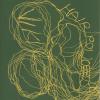 Maybe it's because I heard the song a good ten years after itscreation, but I still have a hard time getting my head around SonicYouth's "Death Valley 69." While I can appreciate the song for what itis, a blasted city-dweller's meditation on the desolate West, and allthe kitsch-laden horror stories coming with it, I've never been able toget as much from the listening experience. All the gratuitous filth andtheatrics just haven't mixed right with a real barrenness alsoprojected by the song. Luckily, there are people in Michigan today whoshoulder this dichotomy with ease. Dearborn's Viki plays afrighteningly arid brand of electro, fattened by an upbringing inAmerica's industrial waist, and packed with enough obtuse humor to keepyour eyes watery without quenching the scorched landscape of the music.She has an eerie, Lydia Lunch-ian delivery, twisting crazed yarns ondating, muscle-car culture, and thin lifestyle advice, over ricketybeats and the squelch of cheap electronics. The result is a more agileversion of the crawling beast conjured by Ann Arbor, Michigan's WolfEyes, with an added resilience to make it all the more menacing. Vikiconvinces me that she lives under the same crumbling off-ramps broughtto life in her songs, while cracking jokes in same breath. No smallfeat…and you can almost dance to it. Kentucky's Hair Police are a tadharder to pin down. On last year's Blow Out Your Bloodthey produced thoroughly abrasive, art-damaged rock, the sounds ofvocals or even drums rarely piercing massive walls of distortion andshattered electronic noise. This release sees them in an even greaterstate of shambles, the bursts of noise and effected screams displacedby longer, more spacious sections of rumbling static and destroyedguttural sounds. Even the song titles, like "Night Visitors" and "NotRaft, But Cage" reveal a more sinister, if less bombastic approach thanprevious efforts, bearing titles like "Do You Love Hop Hop?" and "MagicTool, A Big Hammer." If this is the new Americana, I'm sold.
Maybe it's because I heard the song a good ten years after itscreation, but I still have a hard time getting my head around SonicYouth's "Death Valley 69." While I can appreciate the song for what itis, a blasted city-dweller's meditation on the desolate West, and allthe kitsch-laden horror stories coming with it, I've never been able toget as much from the listening experience. All the gratuitous filth andtheatrics just haven't mixed right with a real barrenness alsoprojected by the song. Luckily, there are people in Michigan today whoshoulder this dichotomy with ease. Dearborn's Viki plays afrighteningly arid brand of electro, fattened by an upbringing inAmerica's industrial waist, and packed with enough obtuse humor to keepyour eyes watery without quenching the scorched landscape of the music.She has an eerie, Lydia Lunch-ian delivery, twisting crazed yarns ondating, muscle-car culture, and thin lifestyle advice, over ricketybeats and the squelch of cheap electronics. The result is a more agileversion of the crawling beast conjured by Ann Arbor, Michigan's WolfEyes, with an added resilience to make it all the more menacing. Vikiconvinces me that she lives under the same crumbling off-ramps broughtto life in her songs, while cracking jokes in same breath. No smallfeat…and you can almost dance to it. Kentucky's Hair Police are a tadharder to pin down. On last year's Blow Out Your Bloodthey produced thoroughly abrasive, art-damaged rock, the sounds ofvocals or even drums rarely piercing massive walls of distortion andshattered electronic noise. This release sees them in an even greaterstate of shambles, the bursts of noise and effected screams displacedby longer, more spacious sections of rumbling static and destroyedguttural sounds. Even the song titles, like "Night Visitors" and "NotRaft, But Cage" reveal a more sinister, if less bombastic approach thanprevious efforts, bearing titles like "Do You Love Hop Hop?" and "MagicTool, A Big Hammer." If this is the new Americana, I'm sold.- Viki - No Date
- Viki - No Work
- Hair Police - Not Raft, But Cage
Crouton
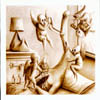 In 1690, John Locke said: "Time is to duration as place is to expansion, and whoever pursues his own thoughts, will find them sometimes launch out beyond the extent of body, into the infinity of space or expansion; the idea whereof is distinct and separate from body and all other things." irr.app.(ext.) says: "Herein, which is the structurelessness of insignificance, possibility is given a reign of manifestation no longer limited by the constraints of possibility, the which can be considered the body."
In 1690, John Locke said: "Time is to duration as place is to expansion, and whoever pursues his own thoughts, will find them sometimes launch out beyond the extent of body, into the infinity of space or expansion; the idea whereof is distinct and separate from body and all other things." irr.app.(ext.) says: "Herein, which is the structurelessness of insignificance, possibility is given a reign of manifestation no longer limited by the constraints of possibility, the which can be considered the body."
What is the way to achieve this structurelessness? This expansion of possibility transcending the body? Why, by subverting your structure into disjecta membra (scattered remains) by the application of Dust Pincher Appliances. The album is the answer to this derationalized notion. The album is a means of achieving voluntary bodily dissolution: the cremation of thought. A series of anti-logical Dada lessons in how to descend the staircase nude without distending your particulars, Dust Pincher Appliances coagulates the diaphanous sounds that emanate, narcotized, from the "antiantedelirationatal music box". Against and before the delirium that logically develops from birth. Cover artwork: Jim Woodring meets Mark Ryden meets Antonin Artaud. A morbidly humorous performance of psychic surgery, the prelude to the Dance of the Tutuguri. Case in point: track four, part b) "bones rattling around oblivion." A shake of the shaman's medicine stick, a juju-needle in your eye, the blood-ooze of the dog star message worming its way around your cerebral cortex. Primal and clinical. Passionate and detached. Track one is vacuumed particles - the Mad Wall-drones that, sucked from your carpet, inhabit your body. Plucked strings inherit your fears, swirling around in a cloud of eraser dust and pencil shavings. Muted and mutable, they are the particulated sounds of dread and debacle being sucked out of the atmosphere and into your vibrating center, so you can no longer hide from irrational devices that whirl and intoxicate.
We are dealing with Irrational Applications of Extreme science. The sound is a bag of sterilized filth, an opportunity for the average human being to display his affection for detritus of the lowest order; a chance communion with all of the scattered effluvia, excretia and aspirated vomit sloughed off in a lifetime of sin. Will you turn away again in disgust, reaching for the toilet plunger, enforcing your corporeal irrelevance? Or will you instead face your foul legacy, and learn to be its equal? Track five: "desist in ceasing to exist," a double negative polarized to repolarize the polar icecaps that strain, crack and break at the influx of echoing underground chambers full of HAARP mindscrapes and digital flushes of modulated brain crimes. A distinctly emotive piece full of hurt and headache. Finally, the culling comes in the form of "wracking the carcass for residue," an industrial throb of obsolescence that entrances as it perplexes. Industrial = IN DUST, a TRIAL = i.e., a baptism achieved through grime. The readymade music boxes of track seven have all the telltale heart of a tale told in part only, and as I slide into this cold wormhole occupied by the hyperstring-membrane, the secret exit tunnel out of a vast abandoned atomsmasher, I know that I must return. I think I lost my contact in there, and out here, I've lost all contact.
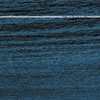 Three years after Dave Pearce released Mirroras Flying Saucer attack, he's now teamed up with Jessica Bailiff toform Clear Horizon. It sounds exactly as I expected a collaborationbetween those two, and I can't imagine anything better. There isn'tmuch indication as to which one of the two initiated the writing on anyof the songs, rather it comes across exactly as what it is: years oftrading tapes of sketches that eventually coalesced into songs. Bailiffdominates the vocal duties, and does a wonderful job. Bathed in reverband echo, just like the surrounding music, she warms the songs intosomething more human than the wintry drones behind her would initiallysuggest. The music is a wonderful throwback to "phase 1" era FlyingSaucer Attack, before he delved more into the beats; simple acousticguitar figures shrouded in white noise and whistling-teapot feedback.It is music completely without edges, enveloping and comforting in asomber sort of way. They only misstep with the closing track, "OpenRoad," driven by a very dated-sounding beat and relatively (veryrelatively) poppy vocals. Though by any other standards a subdued song,it positively roars compared to the rest of the record, and doesn'tplay well with the others. It's easy enough to stop listening before itcomes on though. The rest of Clear Horizon is wonderful enough that you won't want to stop a moment too soon.
Three years after Dave Pearce released Mirroras Flying Saucer attack, he's now teamed up with Jessica Bailiff toform Clear Horizon. It sounds exactly as I expected a collaborationbetween those two, and I can't imagine anything better. There isn'tmuch indication as to which one of the two initiated the writing on anyof the songs, rather it comes across exactly as what it is: years oftrading tapes of sketches that eventually coalesced into songs. Bailiffdominates the vocal duties, and does a wonderful job. Bathed in reverband echo, just like the surrounding music, she warms the songs intosomething more human than the wintry drones behind her would initiallysuggest. The music is a wonderful throwback to "phase 1" era FlyingSaucer Attack, before he delved more into the beats; simple acousticguitar figures shrouded in white noise and whistling-teapot feedback.It is music completely without edges, enveloping and comforting in asomber sort of way. They only misstep with the closing track, "OpenRoad," driven by a very dated-sounding beat and relatively (veryrelatively) poppy vocals. Though by any other standards a subdued song,it positively roars compared to the rest of the record, and doesn'tplay well with the others. It's easy enough to stop listening before itcomes on though. The rest of Clear Horizon is wonderful enough that you won't want to stop a moment too soon.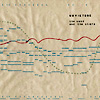 The English city of Bristol is famous for giving birth to such trip-hopluminaries as Massive Attack and Tricky but it is also home to some ofthe best-known space rock bands, most notably Flying Saucer Attack, agroup which over the years has intertwined itself with a number oflocal kindred spirits, such as AMP, Crescent, and Third Eye Foundation.Despite its numerous creative dabblings, FSA has but one ongoingofficial side project: Movietone. Rachel Coe (nee Brook) of FSA startedthe group in 1994, and it currently includes Kate Wright, Matt Jones,John Coe and Sam Jones, along with the assistance of various others on The Sand and the Stars,their fourth full-length album. Since its inception, Movietone hasprogressed further and further in an English folk music direction, butas the band's name suggests, they retain a very cinematic quality,which serves to successfully balance out their overall sound. The titletrack from their latest record is a lovely encapsulation of theiraesthetic. Kate Wright's soft voice comes across as endearingly honest,and is a perfect compliment to the purity of the guitar and piano."Ocean Song" is less minimal, and shows off Movietone's diversity withthe use of banjo, trumpet and tenor saxophone alongside the slowslidings of the guitar, bass and drums. "Pale Tracks" stands as one ofthe best songs on the record because it's a wonderful example of howwell these five musicians really mesh together, both vocally andinstrumentally.
The English city of Bristol is famous for giving birth to such trip-hopluminaries as Massive Attack and Tricky but it is also home to some ofthe best-known space rock bands, most notably Flying Saucer Attack, agroup which over the years has intertwined itself with a number oflocal kindred spirits, such as AMP, Crescent, and Third Eye Foundation.Despite its numerous creative dabblings, FSA has but one ongoingofficial side project: Movietone. Rachel Coe (nee Brook) of FSA startedthe group in 1994, and it currently includes Kate Wright, Matt Jones,John Coe and Sam Jones, along with the assistance of various others on The Sand and the Stars,their fourth full-length album. Since its inception, Movietone hasprogressed further and further in an English folk music direction, butas the band's name suggests, they retain a very cinematic quality,which serves to successfully balance out their overall sound. The titletrack from their latest record is a lovely encapsulation of theiraesthetic. Kate Wright's soft voice comes across as endearingly honest,and is a perfect compliment to the purity of the guitar and piano."Ocean Song" is less minimal, and shows off Movietone's diversity withthe use of banjo, trumpet and tenor saxophone alongside the slowslidings of the guitar, bass and drums. "Pale Tracks" stands as one ofthe best songs on the record because it's a wonderful example of howwell these five musicians really mesh together, both vocally andinstrumentally.In terms of songwriting, The Sand and the Starsseems slightly earthier and simpler than Movietone's previous albums.On the downside, none of the songs are quite as captivatingly beautifulas "Hydra" or "Star Ruby" from their last record, The Blossom Filled Streets.Nevertheless, it's their unfussy approach and cool, breezy musicalbeauty (the album was recorded on a beach, and it shows) thatultimately makes for a very pleasant listening.
 "02/00" starts out with a perverse line of distorted rhythm and melodybefore a brilliant wash of feather-weight synthesizers and piano glideinto position and wash away all sense of perversity. The entire albumfollows suit and the result is as harmonious and complex as it issimple. Each composition is a layered affair; they are equal partsdistortion and clairty and filled to the brim with simple, wistfulmelodies and lighthearted instrumentation. Live instrumentation ismixed with electronic elements in a perfect blend; neither distractsfrom the other and the simplicity of the blend almost completelyeliminates all notions of difference between the two. Sumptuous groovesand vacuous sound effects collide and blend with eachother while moregentle and natural sounds rise above everything like a fine mist. "PassBy" thoughtfully plays out an easy-going piano stroll repeated over andover again above a crunchy (but slick) rhythm section full offuturistic cars passing eachother by at high speed. The mesmerizingeffect the two contrasting parts cannot be emphasized enough: BernhardFleischmann has found a way to make dissonance harmonious. Thoughinaccesible sounds are featured in every song, they never crowd themost attractive features of the album. They're used nimbly and withcaution but they add to each composition in a significant way. Thebusy, work-like commotion of "Until the Real Thing Comes Along" iscontrasted by the guitar and vibraphones that glide over the topnaively. It's as if I'm being carried away from all the stress andfrustration of the working world slowly enough to hear its death fadingaway behind me. All of Welcome Touristis filled with catchy and memorable sounds, but it also features warpedsounds that are just as intriguing. "La Desir" and "Sleep" (twopreviously released songs) are mixed to feature vocals right at the endand surprisingly the addition of lyrics so late in the album works verywell. The second disc is a single 45 minute track featuring Fleischmannon a large variety of instruments and Martin Siewert on a pedal steelguitar. Live drums, piano, leaking noise, funky rhythms, a soulful andnocturnal sax, and resounding guitar drones throw themselves up andagainst eachother only to quiet themselves into simple instrumentalduets, solos, and collages. It's a monument of a performance and italmost steals the show away from the rest of the album. Welcome Tourist puts me in an incredibly good mood everytime I listen to it. -
"02/00" starts out with a perverse line of distorted rhythm and melodybefore a brilliant wash of feather-weight synthesizers and piano glideinto position and wash away all sense of perversity. The entire albumfollows suit and the result is as harmonious and complex as it issimple. Each composition is a layered affair; they are equal partsdistortion and clairty and filled to the brim with simple, wistfulmelodies and lighthearted instrumentation. Live instrumentation ismixed with electronic elements in a perfect blend; neither distractsfrom the other and the simplicity of the blend almost completelyeliminates all notions of difference between the two. Sumptuous groovesand vacuous sound effects collide and blend with eachother while moregentle and natural sounds rise above everything like a fine mist. "PassBy" thoughtfully plays out an easy-going piano stroll repeated over andover again above a crunchy (but slick) rhythm section full offuturistic cars passing eachother by at high speed. The mesmerizingeffect the two contrasting parts cannot be emphasized enough: BernhardFleischmann has found a way to make dissonance harmonious. Thoughinaccesible sounds are featured in every song, they never crowd themost attractive features of the album. They're used nimbly and withcaution but they add to each composition in a significant way. Thebusy, work-like commotion of "Until the Real Thing Comes Along" iscontrasted by the guitar and vibraphones that glide over the topnaively. It's as if I'm being carried away from all the stress andfrustration of the working world slowly enough to hear its death fadingaway behind me. All of Welcome Touristis filled with catchy and memorable sounds, but it also features warpedsounds that are just as intriguing. "La Desir" and "Sleep" (twopreviously released songs) are mixed to feature vocals right at the endand surprisingly the addition of lyrics so late in the album works verywell. The second disc is a single 45 minute track featuring Fleischmannon a large variety of instruments and Martin Siewert on a pedal steelguitar. Live drums, piano, leaking noise, funky rhythms, a soulful andnocturnal sax, and resounding guitar drones throw themselves up andagainst eachother only to quiet themselves into simple instrumentalduets, solos, and collages. It's a monument of a performance and italmost steals the show away from the rest of the album. Welcome Tourist puts me in an incredibly good mood everytime I listen to it. -  Ever since I heard Nuno Canavarro's Plux Qubaalbum, I have been waiting for some artist to approximate the closetedbeauty of that record. Esteemed by Christoph Heemann, Jim O'Rourke andothers since its recording in 1988, Plux Quba is a gem ofbedroom electronica, a fractured, dreamy assemblage of treated vocals,simple electronics and brilliantly restrained melodica. It cannot besimple coincidence that the same label to reissue Plux Quba in1998, O'Rourke's Moikai, is now releasing Orton Socket's debut, a discthat owes much to Canavarro's unique style. Orton Socket is theunlikely project of Ray Mazurek, member of the Chicago Underground Duo,Isotope 317 and others, but that would be hard to guess based on thismusic, a delicate patchwork of digital sounds, lacking definitestructure or even grounding rhythms. 99 Explosions differs from Plux Qubain that, twelve years on, Mazurek has a greater variety of sounds athis disposal, but structurally, it is very similar. The songs enjoy aspare, though non-repetitive structure, with more than one distinctsound rarely occupying the listener. Every piece travels through dozensof individual phrases, each entirely different than its predecessor andarriving in a way that seems both arbitrary, yet in accordance with thedisc's fuzzy logic. Darkly melodic sections appear abruptly butdissolve just as quickly, into low-level hums, shifting glitch effects,and mini, dirge-like drones. Once in a while, rhythms will emerge fromrepeating two-note clusters or metronomic sounds, though they are neverextended, only continued to the point of suggesting furtherdevelopment. Like any great painting, the beauty of 99 Explosionsis the result of its powers of suggestion. In his denial of resolutionor elaboration, Mazurek rends something new from his already beautifulphrases, a unique sound world that exploits listener expectations in anunimposing, delightful way.
Ever since I heard Nuno Canavarro's Plux Qubaalbum, I have been waiting for some artist to approximate the closetedbeauty of that record. Esteemed by Christoph Heemann, Jim O'Rourke andothers since its recording in 1988, Plux Quba is a gem ofbedroom electronica, a fractured, dreamy assemblage of treated vocals,simple electronics and brilliantly restrained melodica. It cannot besimple coincidence that the same label to reissue Plux Quba in1998, O'Rourke's Moikai, is now releasing Orton Socket's debut, a discthat owes much to Canavarro's unique style. Orton Socket is theunlikely project of Ray Mazurek, member of the Chicago Underground Duo,Isotope 317 and others, but that would be hard to guess based on thismusic, a delicate patchwork of digital sounds, lacking definitestructure or even grounding rhythms. 99 Explosions differs from Plux Qubain that, twelve years on, Mazurek has a greater variety of sounds athis disposal, but structurally, it is very similar. The songs enjoy aspare, though non-repetitive structure, with more than one distinctsound rarely occupying the listener. Every piece travels through dozensof individual phrases, each entirely different than its predecessor andarriving in a way that seems both arbitrary, yet in accordance with thedisc's fuzzy logic. Darkly melodic sections appear abruptly butdissolve just as quickly, into low-level hums, shifting glitch effects,and mini, dirge-like drones. Once in a while, rhythms will emerge fromrepeating two-note clusters or metronomic sounds, though they are neverextended, only continued to the point of suggesting furtherdevelopment. Like any great painting, the beauty of 99 Explosionsis the result of its powers of suggestion. In his denial of resolutionor elaboration, Mazurek rends something new from his already beautifulphrases, a unique sound world that exploits listener expectations in anunimposing, delightful way. 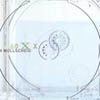 60 x X is the product of a 2002 live broadcast in which Wollscheidengaged every playback device at Frankfurt's Radio X in the continuousplay of pre-recorded music, directing each into his computer and usingthem as sound sources for two hours of live manipulation. At one hour,this disc includes an abbreviated version of the broadcast, dividedinto 60 one-minute sections (hence the title). Upon reading the vagueconcept (something about incorporating new changes in musicbroadcasting and distribution into a "flexible organization of sonicstructures"), and glimpsing the painfully self-referential sleeve art,I braced myself for what was sure to be another inward-looking bore.Too many times I have been seduced by intriguing concepts orexecutions, only to find bland music, incapable of rescue by thecredibility of its origin. Surprisingly, 60 x X is quite the opposite.The piece is downright gripping, progressing in a way that is nevertedious, and Wollscheid's process is more of an afterthought, hardlyindicated by the music. Unlike Philip Jeck and others, Wollscheid isnot interested in looping or layering sound fragments for his newcreations. Any sense of the original material is lost in a shiftinglattice of clicks and cuts that increases in dimension and complexityas the music develops. The sounds of discs skipping occupy theforeground for most of the hour, though they never slip into lullingatmospherics or get lost in too much repetition. Neither is 60 x X ahopeless glitch-fest lacking any structural component. Wollscheidsustains an impressive control throughout, cycling through uniquecall-and-response sections, melancholic passages, and anxious noisebits, while keeping an keen ear turned towards the piece as a whole.From the tiniest of bricks, he has built an elaborate city ofcaptivating spaces, not to go unvisited.
60 x X is the product of a 2002 live broadcast in which Wollscheidengaged every playback device at Frankfurt's Radio X in the continuousplay of pre-recorded music, directing each into his computer and usingthem as sound sources for two hours of live manipulation. At one hour,this disc includes an abbreviated version of the broadcast, dividedinto 60 one-minute sections (hence the title). Upon reading the vagueconcept (something about incorporating new changes in musicbroadcasting and distribution into a "flexible organization of sonicstructures"), and glimpsing the painfully self-referential sleeve art,I braced myself for what was sure to be another inward-looking bore.Too many times I have been seduced by intriguing concepts orexecutions, only to find bland music, incapable of rescue by thecredibility of its origin. Surprisingly, 60 x X is quite the opposite.The piece is downright gripping, progressing in a way that is nevertedious, and Wollscheid's process is more of an afterthought, hardlyindicated by the music. Unlike Philip Jeck and others, Wollscheid isnot interested in looping or layering sound fragments for his newcreations. Any sense of the original material is lost in a shiftinglattice of clicks and cuts that increases in dimension and complexityas the music develops. The sounds of discs skipping occupy theforeground for most of the hour, though they never slip into lullingatmospherics or get lost in too much repetition. Neither is 60 x X ahopeless glitch-fest lacking any structural component. Wollscheidsustains an impressive control throughout, cycling through uniquecall-and-response sections, melancholic passages, and anxious noisebits, while keeping an keen ear turned towards the piece as a whole.From the tiniest of bricks, he has built an elaborate city ofcaptivating spaces, not to go unvisited. Now this is what electronic-tinged folk is supposedto sound like. After all the hype that this sub-genre has received,after countless hit-and-miss or just plain miss releases, let it beknown that Davide Balula gets it right. Pellicule is his debutfull-length and it shows a tremendous gift for melody and mixing it alltogether just so, with no glaring errors or flaws from which pointsshould be deducted. Balula doesn't just write songs: he createsatmospheres for his little organisms to cohabitate or war against eachother or form parasite-host relationships. The emphasis is on the notesthat are played, and what is used to create them is almost incidental.Most tracks do not even feature vocals, and it's of little consequence,as the warm tones and noodling devices still sound like the outpouringof a very genuine heart. When there are words they are in English orFrench, and those on the album's opener are convoluted and random atbest, but then that's kind of the point. This is supposed to be musicthat requires examination before its ultimate purpose is realized.Every time I listened to this record I picked up something I hadn'theard before, and it differed when I was playing it in my car, on myhome stereo, or on my portable with headphones. These are just pure,sweet, guitar-based laments with pulsating beats and processed breaksgalore. At the end of it all, it's a compelling and heartfelt creation,one that is sure to infect anyone who takes it on.
Now this is what electronic-tinged folk is supposedto sound like. After all the hype that this sub-genre has received,after countless hit-and-miss or just plain miss releases, let it beknown that Davide Balula gets it right. Pellicule is his debutfull-length and it shows a tremendous gift for melody and mixing it alltogether just so, with no glaring errors or flaws from which pointsshould be deducted. Balula doesn't just write songs: he createsatmospheres for his little organisms to cohabitate or war against eachother or form parasite-host relationships. The emphasis is on the notesthat are played, and what is used to create them is almost incidental.Most tracks do not even feature vocals, and it's of little consequence,as the warm tones and noodling devices still sound like the outpouringof a very genuine heart. When there are words they are in English orFrench, and those on the album's opener are convoluted and random atbest, but then that's kind of the point. This is supposed to be musicthat requires examination before its ultimate purpose is realized.Every time I listened to this record I picked up something I hadn'theard before, and it differed when I was playing it in my car, on myhome stereo, or on my portable with headphones. These are just pure,sweet, guitar-based laments with pulsating beats and processed breaksgalore. At the end of it all, it's a compelling and heartfelt creation,one that is sure to infect anyone who takes it on. 


